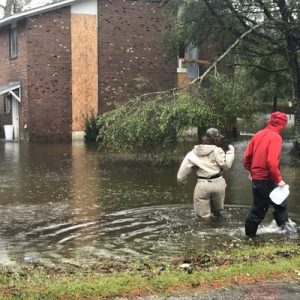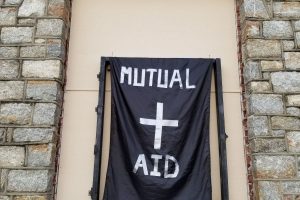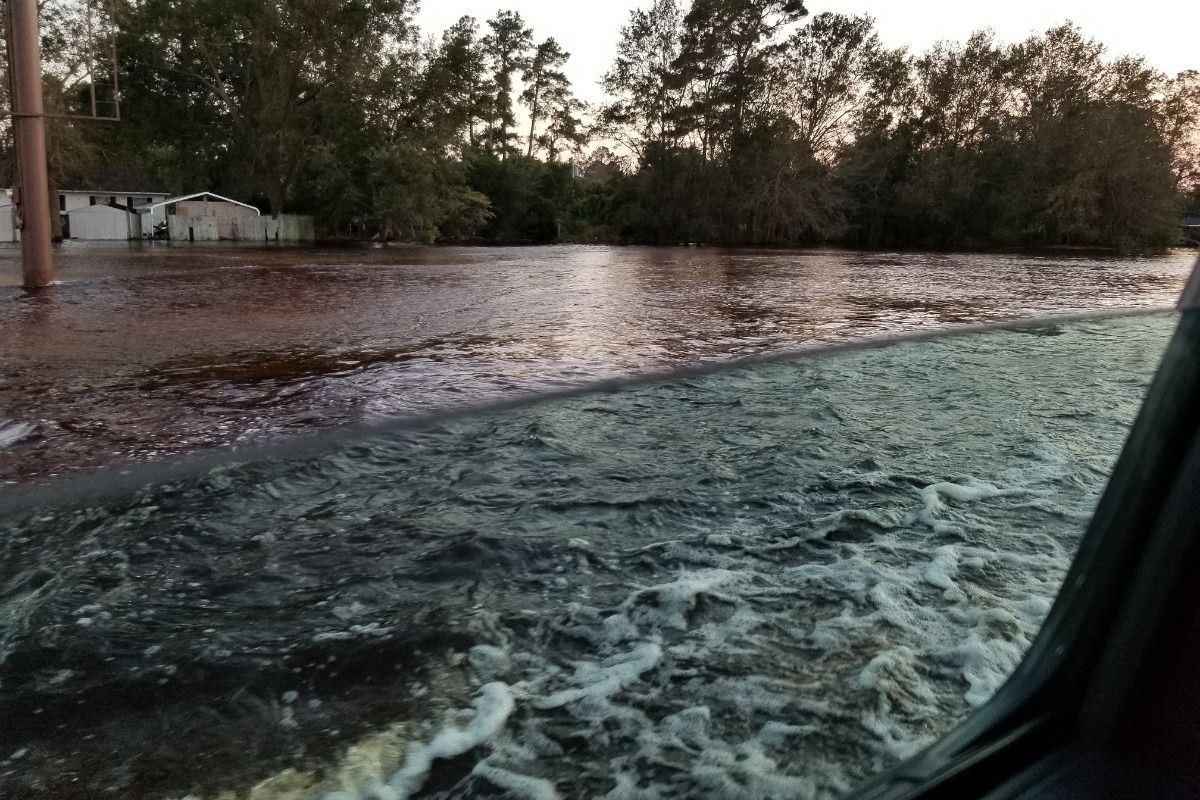As the disaster of capitalism and capitalism-driven climate change fuels larger and more devastating ecological disasters, such as monstrous hurricanes and record breaking wildfires, the need for disaster relief responses that do not further disempower the people living in the aftermath of these disaster-affected areas becomes ever more apparent. Ecological disasters always most adversely affect the poor and working class neighborhoods of an affected area.
The structures of homes in these neighborhoods are often less stable than wealthier areas, people are less likely to be able to stock up on enough supplies to last through the disaster and weeks following, and state and federal responses in disaster affected working class areas (particularly working brown and black working class neighborhoods) are of increased policing and militarization. Hierarchical and bureaucratic responses from organizations and agencies such as FEMA (Federal Emergency Management Agency) and the Red Cross bring militarization and red tape, but little relief, to disaster-affected areas. As a trained emergency medical first responder who has participated in grassroots, community-based and non-hierarchical disaster relief efforts, I have repeatedly experienced the necessity of working with, not over, affected communities, and participating in work that is responsive to local needs.
The Massive Shortcomings of Large NGO and State-Based Disaster Response
In an investigative report, Propublica and NPR detailed how the Red Cross consistently mismanaged and ineffectually used the millions of dollars donated to them for disaster relief following Hurricane Isaac and Sandy in 2012. In 2005, The Red Cross released a similar report of their own following their disaster response in the aftermath of Hurricane Katrina that led to massive public criticism. The 2005 report emphasized their commitment to not repeat the same errors as they did in New Orleans. Years later, the Red Cross is engaging in the same patterns.
So, what are the consistent problems with large, bureaucratic relief organizations such as the Red Cross? Disaster-affected residents, community disaster relief groups, investigative reporters, and internal management of these large organizations are all say similar things — that the Red Cross uses large portions of their donations for administrative pay and public relations projects, does not adequately redistribute their relief supplies to local relief organizations, does not adequately work with local community members/groups who understand the local needs of an affected area, and responds to requests of disaster affected residents in inflexible and bureaucratic manners.
The Federal Emergency Management Agency has received vastly similar criticism of their responses in disaster-affected areas. FEMA’s arrival in a disaster-affected area often coincides with heavy police, national guard, and border patrol presence. In my disaster relief work, I have witnessed the food and water distribution supplies points run by FEMA. These distribution sites are heavily guarded and operated by police, national guard, and border patrol. Imagine how unwelcoming this environment would feel to undocumented folks and people who are often the target of racist police and state violence.
 Rather than working with local community and church organizations who understand the needs of their affected neighborhoods, FEMA chooses to work with policing agencies and creates an unwelcoming and militarized presence in the middle of a crisis. In my relief work, I have spoken with hurricane survivors living in low-income black neighborhoods who have described how police and military helicopters spotlit their neighborhoods all night long, and how FEMA trucks drove through their battered neighborhood streets without stopping to offer any tangible aid. These neighbors have detailed how the police response in their neighborhood was one of arresting people for standing on the sidewalks outside their homes after curfew hours rather than offering any material aid.
Rather than working with local community and church organizations who understand the needs of their affected neighborhoods, FEMA chooses to work with policing agencies and creates an unwelcoming and militarized presence in the middle of a crisis. In my relief work, I have spoken with hurricane survivors living in low-income black neighborhoods who have described how police and military helicopters spotlit their neighborhoods all night long, and how FEMA trucks drove through their battered neighborhood streets without stopping to offer any tangible aid. These neighbors have detailed how the police response in their neighborhood was one of arresting people for standing on the sidewalks outside their homes after curfew hours rather than offering any material aid.
These oppressive state responses are not isolated incidents. Local police in Gretna, the bordering town to New Orleans, are infamously known for blocking the bridge to their town from hundreds of mostly black survivors of hurricane Katrina, who were attempting to flee the devastation. Police shot their weapons into the air and forcibly turned back the refugees. In another horrific incident, police stopped a group of all black unarmed survivors from crossing the Danziger bridge where they were attempting to cross and seek survival supplies. Police responded by opening fire into the crowd, killing two people, 17-year-old James Brissette, and Ronald Madison, a 40-year-old disabled man, and severely injuring four more. In another grisly police killing, an unarmed black survivor, Gregory McRae, was shot to death by local police as he was searching for baby supplies at a closed strip mall. The police then burned his body.
In Puerto Rico, FEMA was heavily criticized for letting over 10 million bottles of drinking water perish in the sun because they deemed the the Puerto Rican survivors of catastrophic hurricane Maria no longer needed the fresh water. FEMA officials claimed that “commerce was coming back” to the devastated island and that they “didn’t want to injure the economy more than it already was.” This is the reality of state response to disasters. The state is more interested in preserving law, order, and commerce than aiding the people directly affected by disasters.
In a horrific example of police responses in the face of ecological disasters, two sheriff deputies in Conway, South Carolina, who were transporting two women to a mental health facility in deadly post-hurricane Florence flood waters, knowingly bypassed barricades that blocked flooded-out roads, resulting in the drowning death of the two women inside the van. The van became stuck in the flood waters and the deputies escaped by standing on the top of the van while the women inside the transport van drowned. These two women, Windy Newton, 45, of Shallotte, North Carolina, and Nicolette Green, 43, of Myrtle Beach, South Carolina, lost their lives to a system that consistently devalues the lives of people in mental health crisis, and to a system that responds to ecological disasters through valuing law and order over human lives.
A Non-Hierarchical Approach to Disaster Relief
So, then, what is the alternative to state-based and large NGO responses to disaster relief?
 My disaster relief work, and the work of my peers, is centered in following the lead of those most affected by a disaster. Conceptually, we talk about mutual-aid and solidarity rather than charity. We don’t view ourselves as the experts in a community’s recovery process and strive to involve disaster survivors and local organizations in every step of our relief work. Basing our work in mutual-aid means that we recognize that in every disaster situation, the first responders are the neighbors helping neighbors, and that survivors of a disaster should not be reduced to helpless individuals who must participate in top-down charity models, but rather, can be integrally involved in the recovery of their own communities. Within our own group, we resist hierarchical organization and make decisions through consensus and trust rather than hierarchy or coercion.
My disaster relief work, and the work of my peers, is centered in following the lead of those most affected by a disaster. Conceptually, we talk about mutual-aid and solidarity rather than charity. We don’t view ourselves as the experts in a community’s recovery process and strive to involve disaster survivors and local organizations in every step of our relief work. Basing our work in mutual-aid means that we recognize that in every disaster situation, the first responders are the neighbors helping neighbors, and that survivors of a disaster should not be reduced to helpless individuals who must participate in top-down charity models, but rather, can be integrally involved in the recovery of their own communities. Within our own group, we resist hierarchical organization and make decisions through consensus and trust rather than hierarchy or coercion.
In contrast to FEMA and the Red Cross, our team connects with local community groups, churches, and makes individual connections with folks we meet on the streets, in order to gather information on what kind of relief people most need in specific disaster-affected neighborhoods. If we already have connections in an area, our team will contact that group or person before deploying to an area and ask how we can best help. This may look like putting boots on the ground, raising funds or supplies to send to a local group, helping set up a relief supplies distribution site, providing first-aid support, etc.
Community Led Efforts
When our team helped set up a distribution site in Wilmington, NC during post hurricane Florence relief efforts, we worked out of a local non-profit space. When neighborhood residents who came to the distribution site for relief supplies expressed an interest in helping with the distribution effort, we immediately welcomed them. Within two days, the majority of the distribution volunteers were people who had originally come seeking aid. The space was not run by a bureaucratic organization or authoritative figures, but by neighbors, and our team, who gladly followed the lead of the local community.
 The distribution point was no less organized without a designated “leader” or hierarchical system of organization. People organically filled roles that they were useful in and an efficient system was created through a group effort. The atmosphere was welcoming and compassionate, and people on both sides of the supply tables could relate to each other as neighbors and equal participants in their disaster recovery. This disaster survivor-led relief effort was a poignant example of mutual-aid, as people came for help and stayed to offer help to their fellow neighbors. The neighborhood folks knew the needs of their community better than we, as outsiders, could. They would communicate to us what relief items were most needed and we used our funds and organizational connections to obtain the needed supplies.
The distribution point was no less organized without a designated “leader” or hierarchical system of organization. People organically filled roles that they were useful in and an efficient system was created through a group effort. The atmosphere was welcoming and compassionate, and people on both sides of the supply tables could relate to each other as neighbors and equal participants in their disaster recovery. This disaster survivor-led relief effort was a poignant example of mutual-aid, as people came for help and stayed to offer help to their fellow neighbors. The neighborhood folks knew the needs of their community better than we, as outsiders, could. They would communicate to us what relief items were most needed and we used our funds and organizational connections to obtain the needed supplies.
Disaster Relief that Builds Relationships and Community
Through having made local connections, we were directed to the most affected areas and sent to specific homes that neighbors knew needed relief or were occupied by vulnerable people. By maintaining the distribution site as well as having roving street teams, we were able to ensure that folks who could not make it to distribution points were not left behind. We also were able to build meaningful relationships by sitting on porches with people and breaking bread as we provided assistance.
There is great meaning in bringing someone much needed baby supplies to their flooded home and then sitting down and accepting homemade tacos made from a single-burner stove kit. This is also mutual-aid and resists the savior/victim dynamic. We do not seek to replicate state or charity-based systems or institutions through our relief effort. Rather, we seek to build long-term relationships, encourage community empowerment, and fight against the racism, sexism, and classism that permeates many mainstream disaster relief spaces. When disaster relief is rooted in a non-hierarchical approach, disaster survivors can maintain a sense of personal agency and equal participation in their own recovery process.

